
Zach Collaros
Written by Kip Earlywine
Part I, Part II, Part III
Call it a hunch, but I get the feeling Seattle’s preference in this draft is not to find a franchise QB, or even a diamond in the rough, but rather their own version of Matt Flynn. A guy who can be a very good backup, good enough to interest other teams when he eventually becomes a free agent. Or even a guy that could draw enough interest for teams to make a trade- the same way that Matt Schaub, Matt Cassell, and Kevin Kolb have done.
The more I think about it, the more realistic Wisconsin’s Russell Wilson appears. I think if we are honest about it, Wilson’s only real problem are his perceived durability issues. You look at the massive line he excelled behind at Wisconsin and wonder where his height issues went. Truthfully, I don’t think height is a problem for Wilson, but durability is harder to discount. Wilson weighed in at the combine at 204 pounds, and while that’s not bad for a sub 5’11” player, how is that body going to hold up when getting smashed by 350 pound lineman? Wilson seems unlikely to hold up over a 16 game schedule year after year, yet it almost feels like Wilson is destined to be the NFL’s greatest career backup (which is more or less what Doug Flutie was). If he only plays a few games a season, he’ll probably get by. Most teams don’t like the idea of drafting a guy late that may not realistically have a chance to be the next Jake Delhomme or Matt Hasselbeck, but Seattle could be one of the few who are okay with such a proposition.
That’s what I think they’d like to do, anyway. What they do in the draft will be directly impacted by the events of free agency. What if they pull off a trade for a quarterback who could beat Jackson out as the starter? What if they sign a free agent who could do the same? What if nothing comes together and they walk into the 2012 draft with only two quarterbacks? If Seattle strikes out and walks into the draft with only two signal callers, they might have to choose from a rather select group of quarterbacks who are NFL ready and could at least compete with Jackson to start right away. If Seattle brings in a low cost veteran to compete with Jackson (Orton, Campbell, etc), that might make them comfortable enough to draft a Matt Flynn type- a savvy quarterback with physical limitations. If Seattle gets a big name quarterback who can clearly beat out Jackson for the starting job, that frees up Seattle to do whatever they want in the draft, potentially even drafting another Josh Portis type project with some upside who can compete for the final quarterback roster spot.
In this 4th installment, I’m going to look at 3 more quarterbacks, one for each of the scenarios above.
~
Brandon Weeden. Size: 6’4″, 221. Class: Sr. Age: 28

It might seem a little weird putting Weeden in this group, but I look at Weeden’s age and the competition he’ll face from younger quarterbacks like Tannehill and Osweiler, and I find it hard to believe he’s going to go terribly early in the 2012 draft. Weeden’s situation is unusual, but not unprecedented. In fact, his story is strikingly similar to that of Chris Weinke 11 years ago. Like Weeden, Weinke turned down college football to play baseball. He’d make it all the way to triple-A in the Blue Jays minor league system, but gave it up to return to football. He committed to Florida State University at the age of 25, and three years later, Weinke became the oldest Heisman trophy winner in history. He entered the 2001 draft coming off that terrific season and was also 28 years old.
Chris Weinke would be a 4th round pick.
So while its possible that Weeden could go as early as the 2nd round, history suggests that he will be a mid rounder. Weeden turns 30 in October of next year. That’s going to impact how GMs value him, as it once did for Chris Weinke.
While Weeden’s age is a major drawback, it could be a drawback that plays to Seattle’s favor. If Seattle enters next year’s draft with only two quarterbacks, they would likely seek a player with enough experience and maturity to at least make Tarvaris Jackson sweat for his job a little bit. Its really hard to find a rookie quarterback who can do that right away, especially for a team that would prefer not to spend a high pick doing so. You would need a very unique situation for such a thing to be possible, and Weeden presents exactly such an opportunity. Seattle wouldn’t care as much about his age, because the Seahawks are one of a handful of NFL teams actively searching for a bridge quarterback. Lets not forget either that Seattle was very interested in guard Danny Watkins last year, so the age of a prospect might not be as big an issue for this front office as it would be for many others.
Weeden is a former pitcher, but you wouldn’t know it based on his accuracy. His accuracy is very inconsistent. Even in Weeden’s victorious Fiesta Bowl performance, roughly 30% (by my count) of his passes were overthrown, underthrown, or forced his receivers to stretch out for the catch. I find it almost unfathomable that he completed over 72% of his passes last year. Nearly every pass Weeden threw was snapped from the shotgun, so under center ability is a question mark. Weeden often stares down receivers, and he’s prone to make blind spot throws a few times a game where he doesn’t even notice the defender threatening his passing lane.
On a positive note, there are things to like about Weeden beyond his terrific numbers. He has prototypical size and he just “looks the part” of an NFL quarterback physically. Weeden’s athleticism and speed is roughly on par with Matt Barkley’s, which is probably enough for him to be adequate in our offense. I was really impressed by Weeden’s pocket presence too. He feels pressure so well that he doesn’t need a ton of speed to escape it. Weeden’s accuracy might be inconsistent, but his velocity is not. Weeden has one of the better arms in the draft, and one of my favorite things about him is the amount of zip he delivers on his 15-25 yard strikes. His mechanics aren’t textbook, but I would consider them above average. His release point is high enough and his windup is a little elongated but still quick. His footwork is well spaced and fluid. Its not hard for me to see him quickly adapting to an under center offense. And while its true that Weeden will lock onto receivers with upsetting frequency, he’ll just as often progress through multiple reads and very quickly diagnose open receivers. The speed at which he goes through those reads is very impressive. What I like most of all about Weeden is how he has almost a Peyton Manning ability to get rid of the football quickly. Its very rare that the football will still be resting in Weeden’s hands four seconds after the snap. Of course, Weeden is playing in a spread offense, which would partially explain why he can find targets so quickly.
Still, there is a bit of a Tarvaris Jackson vibe I get when watching Weeden. A lot of his reads feel forced, almost “wooden.” When a receiver isn’t wide open, he seems to agonize over it. He also throws very, very few passes away, and that would need to change at the next level.
So is Weeden actually NFL ready? I think that depends on what you are looking for. Weeden isn’t a project, he’s just a flawed quarterback with some talent (I feel the same about Darron Thomas). Similar to Tim Tebow or Jake Locker, I think what you see is what you get. Both Tim Tebow and Jake Locker had some success last year despite the fact that their college level flaws remained evident.
The biggest problem for Weeden is how he can sometimes be a bit of a robot… although there are stretches were his robot button gets switched and he suddenly looks like the Terminator. My experience is that quarterbacks with mental limitations usually don’t grow out of them, they either succeed despite them or they don’t. With the exception of having to learn the playbook and adapt to playing under center, I think Weeden is as NFL ready in 2012 as he’ll be in 2014. He’s not a guy I expect to grow, but that doesn’t mean he couldn’t be a solid, possibly even good, quarterback at the next level.
Expected draft trajectory: Rounds 2-4.
~
Kellen Moore. Size: 6’0″ (5116), 197. Class: Sr. Age: 22

Finally, northwest native Kellen Moore gets his turn at the wheel. I know some of you have been waiting eagerly for this, if only for the entertainment value. So here we go…
In many ways, Moore is a bizarro Tim Tebow. Physically they are nothing alike- left handedness aside. Yet both are quarterbacks with phenomenal college careers that have flaws so severe that it turns their NFL projection into a bit of a punchline. Josh McDaniels believed so strongly in Tebow’s intangibles that he made the Florida legend a surprise 1st round pick. Moore won’t be drafted nearly as high, but I think its pretty likely he will be drafted somewhere based on his intangibles alone. If Moore is a successful NFL quarterback some day, that success will be met with surprise, laughter, amusement, and even excitement, the kind of excitement that comes with a strange and inexplicable sports storyline. Tebow-mania. Linsanity. The value of Tim Tebow and Jeremy Lin is not derived from their play. Its from the narrative their emergence itself provides. Tim Tebow was never supposed to be an NFL quarterback. Jeremy Lin should be using his Harvard degree to trade stocks somewhere, not vault the horrid Knicks into playoff contention. Moore might not be a successful NFL quarterback, but I don’t think he’ll have a boring NFL career.
And while Moore doesn’t come close to fitting the classic description of a point guard quarterback, he might interest Seattle if they are indeed looking for a Matt Flynn type or if they are looking to draft two quarterbacks instead of just one (something Schneider recently hinted at). Like Matt Flynn, Moore doesn’t have a cannon arm nor does he have even average athleticism. However, in a recent John Schneider radio appearance (more on that later), he revealed that the top attribute he looks for in a quarterback is leadership, a guy “who tilts the field his way.” Moore is one of the best quarterbacks in the draft in this department. He’s a guy who wasn’t supposed to amount to anything yet broke records and went 50-3 as a starter. As you might have heard, that’s the most wins in college football history. He also showed up to the combine and worked his ass off, even stepping in for throwing drills when many superior quarterbacks refused to. Its said that Moore was surprisingly impressive in those drills too.
If nothing else, that left a positive and memorable impression for all the evaluators in attendance. John Schneider once said that he never forgot watching Charlie Whitehurst throw passes in the wind and rain many years ago. He still remembered that moment five years later when he traded for the Chargers’ quarterback. Sometimes little impressions can go a long way in the mind of a general manager. That could make Moore a surprise candidate for Seattle in the very late rounds if he’s still around, despite his lack of fit for the scheme. Matt Flynn didn’t exactly fit Green Bay’s physical preferences either, but they saw something in the guy and gave him a chance to compete.
As far as what I think about Moore, I like the guy, but let me get some caveats out of the way. First, obviously, his size. He’s just under 6 feet tall and can’t even break 200 pounds. He has skinny legs and arms- he looks like he’d snap if Ndamukong Suh so much as looked at him. In terms of stature, he reminds me of Colt McCoy- not a guy you would mistake for a prototypical quarterback at first glance. I don’t think height will be as big a concern as many think (I’ll cover that in the positives), but whenever a quarterback is that short, there is always a very strong chance he could be the next Max Hall who throws terrible picks in the NFL because he can’t see anything. Like Weeden, Moore played in a spread offense and when I watched his game footage from Georgia, he took only one snap from under center. Moore has below average raw athleticism, and his deep throws lack distance and zip. He has a bit of a clunky delivery (although its fast enough) and his footwork could use some work too. He makes a lot of ugly/awkward off balance throws (though to his credit, they remain accurate). Finally, it should be noted that Moore played on a team with national champion level talent in a non-BCS conference. Boise state has a great coaching staff, a defense that occasionally boasts NFL talent, a great offensive line, some good receivers and one of the nation’s better running backs in Doug Martin. So like Flynn, Moore benefited tremendously from the environment he played in.
Wow, that was a wall of text wasn’t it? Kellen Moore’s issues when projecting to the NFL are numerous and significant. And yet, I think there is a tiny bit of truth to the Tom Brady comps some fans give Moore. Brady is 6’4″, 225. Obviously, Moore will never physically be Brady’s equal, but the similarities are there. First, like Brady coming out of Michigan, Moore has a ton of potential to add weight. Whereas Russell Wilson looks pretty maxed out at 204 pounds, Moore is an almost embarrassingly skinny looking 197, and its certainly within Moore’s potential to bulk up an extra 10-15 pounds. If he could reach the 210-215 range, he’d still be a worse than average injury threat, but at least he’d be reasonably close to the 220 pound minimum many teams prefer. Moore doesn’t run the ball much and is smart about avoiding contact, so 210 pounds might be enough to make him a viable 16 game starter health wise. I’d say in no uncertain terms that Moore must add weight, and its legitimate to wonder if that could impact his mobility even further.
Earlier I compared Moore to McCoy in terms of physical appearance. That said, I don’t believe that Moore has a Colt McCoy career in store for him. Moore is a far superior quarterback- its not even close. Moore has outstanding decision making and almost never has an off game. McCoy had good intangibles but was incredibly erratic. Moore is better across the board in many ways that I will address shortly. I would only compare the two in terms of physical limitations.
There is a lot to like about Moore. Moore gets rid of the ball with incredible speed. In the Georgia game, I don’t know if he held the ball in his hand for 3 seconds even one time. He doesn’t lock onto receivers and he progresses through reads with a high degree of comfort. In a few cases he checked his 2nd read and delivered the ball a few tenths of a second later- that’s some astonishingly fast recognition time. Dare I say elite. While its true that Moore was sacked very little and played behind a great offensive line against inferior competition, I think the true reason for the sack total is Moore’s ability to get rid of the football with such consistent quickness. Its awfully hard to sack a quarterback when the ball is consistently gone two seconds after the snap.
Moore’s ability to make pre-snap reads and adjust on the fly are both very impressive. Moore’s intelligence is extremely high. Watch this video where he breaks down X’s and O’s and try not to be impressed. He doesn’t sound anything at all like a college quarterback. Pay close attention to how he talks about defensive positions and how he specifically diagnoses how big a threat each defender is to intercept his pass. He has a mental system that is designed to very quickly diagnose “yes” or “no” on a read, and if its not there, he moves to the next option very quickly. This explains a great deal about why Moore’s reads are so fluid and quick. John Schneider himself recently said that Moore’s intelligence and instincts “are off the charts.” I would tend to agree.
Moore doesn’t have a ton of athleticism, but he still runs an effective bootleg. He generally has good pocket presence and is surprisingly agile and elusive. He’s not going to run the ball, but you don’t have to run the ball as a Quarterback to accomplish what Seattle wants on offense. Overall his mobility was pretty close to average, which surprised me.
Moore has a “floaty” deep ball and offensive coordinator Brent Pease wisely minimized deep routes in his game plans. Yet for having such a weak arm, Moore’s short and intermediate passes pack a ton of zip. Overall, his arm is highly comparable to that of Matt Hasselbeck. It could be interesting to see how Pete Carroll would scheme Moore into his offense since it strongly emphasizes a vertical passing game. I think Carroll could make it work, since after all, he turned a noodle armed Hasselbeck into a surprisingly potent deep threat quarterback in 2010 with Jeremy Bates. While its true that Moore’s deep ball is a strike against him coming here, there is something to be said for just how deadly Moore can be with mid range throws. Seattle’s offense throws a lot of passes 15-25 yards downfield, and Moore is one of the more deadly mid range quarterbacks in this draft due to the strength of his reads and the zip on his intermediate passes.
As far as Moore’s height, will it really be an issue? Like Russell Wilson, Moore played behind a pretty big offensive line in college and didn’t suffer from a barrage of tipped passes. Not once did I see a play where Moore struggled to see his receivers or the defenders covering them. Moore isn’t going to win gold medals on the track, but he does have some short area quickness which helps him maneuver to find throwing windows very quickly.
Bottom line, does Moore fit the point guard role Seattle is seeking? Yes, sort of. He won’t often run beyond the line of scrimmage, but he’s mobile enough to escape pressure and can extend plays. I think Moore falls into a very similar category as Russell Wilson, a guy with incredibly strong intangibles and the kind of skills Seattle is looking for at quarterback. Moore will never be a prototypical franchise quarterback, but that doesn’t mean he can’t be successful if he goes to the right team- a team that can adjust to suit his strengths and weaknesses. Overall I came away from my evaluation surprisingly believing of Moore. His determination is palpable and while his obstacles are perhaps insurmountable, his talent is the real thing. I’d be pretty excited if Seattle drafted him, if only because he is such a wildcard.
Expected draft trajectory: Mid to Late round pick.
~
Zach Collaros. Size: 6’1″ , 218. Class: Sr. Age: 23

Zach Collaros represents an example of a quarterback Seattle might target in a best case scenario. Yesterday Rob provided some new information about the trade Seattle has on the table, which means it is possible that Seattle could acquire a big name quarterback depending on where Peyton Manning signs. If Seattle trades for an established quarterback like (hypothetically speaking) Tony Romo, that would allow them to draft a Josh Portis-type project with nice upside, should they so desire.
Collaros is worth mentioning because he’s got a decent chance to go undrafted and has many similarities to Chandler Harnish. Both have similar size and athleticism. Neither one is a stranger to ripping off 50+ yard touchdown runs at any given moment. Both are classic point guard quarterback types who flash strong intangibles and the ability to progress through reads and distribute the football. I think Collaros holds onto his first read a little too long at times, but overall I’ve been impressed with him when I’ve seen him. He has a Josh Freeman type ability to dodge pass rushers and get off desperate looking last second throws that are often completed for big plays.
Callaros is a gutty player who has the respect of his coaches and teammates. Cincinatti posted a 10-3 record and won the Big East thanks in large part to Collaros’ leadership and playmaking ability. Collaros did struggle a bit with interceptions. After avoiding a pick through his first three games, he went on to toss 10 picks over his last 7 starts.
I think Harnish is the better quarterback, but Collaros could be an appealing option at the end of the draft depending on how the previous rounds go.
Expected draft trajectory: Late round pick / UDFA.
~
For those who haven’t heard it yet, Seahawks GM John Schneider had a recent radio interview with Brock and Salk (skip to about the 15 minute mark). Lots of good stuff in there, I’d highly recommend giving it a listen. Here were a few of my highlights:
#1) While describing what he looks for in a quarterback, John Schneider threw a couple quarterback names out there- probably just the first two that came to his mind. Those quarterbacks? Chandler Harnish and Austin Davis.
#2) He listed leadership, mobility, elusiveness, and keeping eyes down the field as major attributes he looks for in a quarterback.
#3) He had a rather cryptic anecdote about Reggie White, saying that “the time was right” to make a major signing like White (the Packers were already contenders with Favre and White put them over the edge). He then had a reverse example talking about a time when they signed a 32 year old defensive end before the team was ready for that kind of move and how it set the team back. Those stories strongly suggest that Seattle is leaning against a major free agent addition this offseason, as the Seahawks are clearly not in their championship window just yet. His comments could also hint against free agents over the age of 30. I don’t think John Schneider was being terribly nuanced here, and it makes me pretty skeptical that Mario Williams will be a Seahawk next season.
#4) Last of all, Schneider suggested the intriguing possibility of drafting two quarterbacks this year… sounded 100% serious too. This is a deep quarterback class in the mid to late rounds. Drafting two quarterbacks in a year like this makes an awful lot of sense.
























